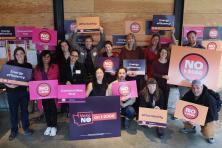More Rage Against the Manchin
Late last week, US Senator Joe Manchin (WV) made it clear that he will not support the Clean Electricity Performance Program before the U.S. Senate, effectively killing an essential part of the Biden-Harris climate plan that would have greatly accelerated getting the country on a path to 100% clean electricity. Congress was considering it as part of current and ongoing budget reconciliation negotiations.
Sen. Manchin’s home state of West Virginia is now more exposed to increased flooding than anywhere else in the country, and low-income West Virginians are facing increasing economic hardship due to their reliance on coal. Many have tied the senator’s brash rejection of the broadly supported plan to the voluminous out-of-state campaign contributions he has received from the oil and gas industry, his family ties to the coal industry (through which he made a cool half-million dollars last year), and wondering if the senator is already planning to represent “Wet Virginia” by living on a boat. Meanwhile, experts and legislators got to work to devise other paths for meaningful federal climate pollution reductions through other possible pathways before it’s too late.
After 26 chances, will nations COP to climate change?
Many are saying COP26 is our “last hope,” the last chance for G20 countries to show in detail how they are going to honor their agreements from Paris to keep global warming below 1.5°C. These countries have been making promises for the last thirty years; what is needed now is drastic action. Many world leaders, including officials from China and Russia, are not attending and it’d be easy to view COP26 as a failure before it even starts. While it is critical that nations give clear numbers, they must also remember the lives that are being jeopardized today with only 1.1°C of warming. Chronic exposure to strenuous activities in high heat is leading to kidney disease and deaths of otherwise-healthy outdoor workers in their 20’s and 30’s. Millions of people are also being displaced from their homes with increasing frequency due to climate change and experiencing additional consequences. British Prime Minister Boris Johnson is bringing a plan to COP26 for the UK to be net zero by 2050, while incentivizing £90 billion of private investment in various carbon-free energy developments.
Winds of change (and energy) coming soon
Solar energy typically dominates the headlines for renewables in the US, but last week Interior Secretary Deb Haaland announced the nation’s first long-term strategy for offshore wind development, with her agency exploring potential leases in federal waters in the Gulf of Mexico, Gulf of Maine, and off the coasts of the Mid-Atlantic States, North Carolina and South Carolina, California and Oregon. Biden’s climate push has already set a national goal to generate 30 gigawatts of electricity from offshore wind turbines by 2030 and there’s a big push already underway to ensure work in this budding industry are good-paying, union jobs. So what might offshore wind work look like? Visit Hornsea One off the coast of England with Marketplace.
Trucks and buses and…. tugboats and tractors? Heavy duty electrification on up.
The shift to electric keeps on trucking, with over seventy companies urging governors nationwide to more quickly adopt clean large commercial vehicles. It wasn’t the only major push to reduce emissions from shipping this week, as corporate giants including Amazon, IKEA, and Michelin also announced their commitment to use cleaner maritime fuels with a goal of operating 100% zero-emission vessels by 2040. Meanwhile, local port authorities have begun to enact stronger climate action and electrification plans, with the Port of San Diego committing to transition its diesel truck fleets to battery-electric or some other zero-emission technology by 2030. San Diego’s plan also includes all its diesel cargo-handling equipment, such as cranes, drayage trucks and forklifts, and harbor craft like tugboats. Back on land, an effort to get cleaner fuels to tractors and other off-road agricultural equipment is starting to gain some traction.
One Thing You Can Do
Channel your Manchin rage into grassroots change
Join our colleagues at Chesapeake Climate Action Network to make calls to folks in West Virginia asking them to contact Senator Joe Manchin's office for climate action. Join any Tuesday or Thursday evening this month starting at 6pm ET to get involved. You and other volunteers will be making phone calls to West Virginia voters to talk about the importance of the Build Back Better Act and crucial climate provisions. If the voter is excited about the Build Back Better Act then they will be patched through to Senator Manchin's office to voice their support of the bill. Join CCAN efforts here.




